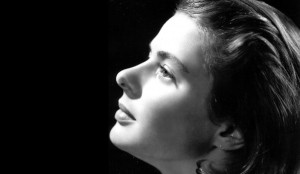Begins on August 22 – September 6 at the TIFF Bell Lightbox.
“More than most stars of her rare magnitude, Ingrid Bergman was an actress who went her own way.”
—Ben Cosgrove, LIFE.com
“Bergman played the whole film without knowing how it would end, and this had the subtle effect of making all of her scenes more emotionally convincing; she could not tilt in the direction she knew the wind was blowing.”
—Roger Ebert on Casablanca
“One of the most necessary film stars in the world.”
—David Thomson, The New Republic
“If you took acting away from me, I’d stop breathing.”
—Ingrid Bergman
In honour of the hundredth anniversary of Ingrid Bergman’s birth on August 29, this superlative season of the actress’ greatest performances in Hollywood films forms a bookend to the very first season of TIFF Cinematheque a quarter-century ago, which featured the films the actress made in Sweden before her departure to America.
The films of Ruben Östlund, recently screened at TIFF Bell Lightbox, take great pleasure in demolishing stereotypes of Swedish rectitude—the very quality for which Ingrid Bergman was celebrated after she left Stockholm for Beverly Hills in 1939, after being coaxed to Hollywood by David O. Selznick to star in a remake of her Swedish hit Intermezzo. Unusually tall and more handsome than beautiful, with a shy smile and earthy laugh, the fresh-faced Bergman embodied the naturalness and integrity that cliché dictated was quintessentially Nordic, as if fjord water ran in her veins. (She insisted to Selznick that she would never alter her wholesome look for the lacquered glamour and brittle artifice of other Hollywood actresses.)
Though Bergman maintained that “purity,” regal in her unadorned modesty, her most memorable roles included alcoholics, amnesiacs and adulteresses—that scarlet letter ‘A’ alliterating with the seemingly imperative ones that so often ended her characters’ names (Alicia, Paula, Anastasia, Henrietta, Anita, Ilsa)—while most of the parts that were designed to win her America’s puritanical adoration (such as the French governess in Adam Had Four Sons) are now forgotten. There was an erotic element to Bergman that emerged even in her most explicitly ecclesiastical characters: her two Joans of Arc—the first for Victor Fleming and the second for Roberto Rossellini, both previously presented at the Cinematheque—were less saintly than sensual, while as a nun in The Bells of St. Mary’s, she could not help but spellbind a priest into something like love.
Bergman famously claimed that her reputation had swung “from saint to whore and back to saint again,” referring to the period that began when, inspired by the harsh realism of Roberto Rossellini’s Rome, Open City, she wrote to the director to express her admiration; ever voracious for truth and artistic challenge, she soon left Hollywood to act in a series of his greatest films. When Bergman gave birth to Rossellini’s child while still married to her dentist husband, she became the new Hester Prynne, denounced on the floor of the United States Senate and, even more damningly, dropped from The Ed Sullivan Show. (As David Thomson recently wrote: “She was beloved, idolized, idealized; if you like, strangers wanted to have sex with her. But when she revealed a similar need, the hounds of voyeuristic disapproval were unleashed.”)
Though Bergman returned to Hollywood after her marriage to Rossellini foundered, and (notorious no longer!) was immediately rewarded for her abandonment of Europe and harlotry with a second Oscar for Anastasia, nothing in her subsequent career—even her memorable performance in Murder on the Orient Express, which won her third and final Oscar—equalled the transcendent films she made with the Italian maestro. (You can see for yourself at the end of August, when TIFF marks the fated date of both Bergman’s birth and death with screenings of her collaborations with Rossellini in our concurrent Summer in Italy series)
“I didn’t choose acting,” Bergman once said, “it chose me.” Wise choice.
—James Quandt
Notorious: Celebrating the Ingrid Bergman Centenary runs from August 22 to September 6 at TIFF Bell Lightbox and includes Casablanca (1943), The Bells of St. Mary’s (1946) and 35mm prints of three Hitchcock classics: Spellbound (1945), Notorious (1946), and Under Capricorn (1949). The final weekend of TIFF Cinematheque’s Summer in Italy (on now until September 5) is devoted to the films Bergman made with her husband Roberto Rossellini, including digital restorations of Fear (1954), Voyage in Italy (1953) and Stromboli (1949).
Please visit TIFF to view a complete schedule of NOTORIOUS: CELEBRATING THE INGRID BERGMAN CENTENARY
– Originally Posted July 24, 2015




Comments are closed.